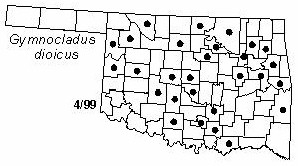Tree to 18 m (60 ft) tall and 50 cm (20 in) diameter. Bark thick, gray, rough, with narrow scaly ridges. Twigs long, thick, hairy when young, dark brown, with large heart-shaped leaf scars. Buds very small, hairy, brown, paired at node, no end bud. Leaves bipinnately compound, 30-75 cm (12-30 in) long, with 3-8 pairs of secondary branches having 6-14 usually paired leaflets. Leaflets ovate, 2.5-6 cm (1-2.4 in) long and 2-3 cm (0.8-1.2 in) wide, nearly sessile, entire, dull green above, pale below. Flowers numerous in large upright terminal clusters appearing in late Spring, each flower about 15-20 mm (0.6-0.8 in) long, hairy, greenish-white. Fruits large thick dark brown pods, 10-18 cm (4-7 in) long and 4-5 cm (1.6-2 in) wide, remaining attached until mid-Winter and falling unopened. Seeds about 2 cm in diameter, hard, shiny, dark brown.
Distribution: Northeast and central U. S. west to Kansas and Oklahoma.
Habitat: Often found in floodplain forests, but may appear in other habitats.
NWI status: none
Comment: This species is the state tree of Kentucky. The raw seeds are somewhat poisonous, but they are said to make a tolerable substitute for coffee if roasted. The seeds are called hully-gullies and are carried as good luck charms by some rural children. Gymnocladus means naked-branched; dioicus refers to the dioecious flowers.
Distribution in Oklahoma: 
BACK
NEXT
RETURN TO INDEX
Last update: 9/10/99
 Go to Oklahoma Biological Survey Home Page
Go to Oklahoma Biological Survey Home Page
 Disclaimer
Disclaimer